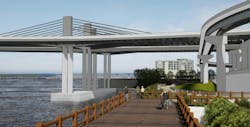I-5 Bridge Replacement Plans Make Progress
Interstate 5 bridge officials recently unveiled renderings of what they anticipate the finished span connecting Oregon and Washington to look like ahead of submitting federal funding applications to fund the replacement.
According to the images, planners have three primary bridge styles in mind: a single-level bridge, a double-decker bridge, and a bridge with a moveable span to allow tall ships to pass underneath, along the river.
Greg Johnson, head of the Interstate Bridge Replacement Program, said in a statement to Oregon Public Broadcasting the renderings show only “design options being considered.”
“This is just to give perspective on the size of the bridge, as related to if you’re standing on the ground on Hayden Island or on the waterfront in Vancouver,” Johnson said.
In addition to the vehicle portion of the bridge, Tuesday’s renderings also show an improved bike and pedestrian path to cross the Columbia River, as well as the telltale overhead power lines for light rail.
“This will be a bigger bridge, and this will have impacts on Hayden Island, but we also think there will be very positive impacts,” Johnson said. He added the new bridge would make the island “more walkable” because it would no longer be bisected by I-5.
It’s not clear when exactly planners will submit their application to federal officials. However, the planning commission said it intends to hand over the plans to the federal government this spring.
The bridge’s final design is also likely to influence the price tag of the project, which planners have so far estimated to be around $6 billion or more.
---------------------------------------------
Source: Oregon Public Broadcasting
